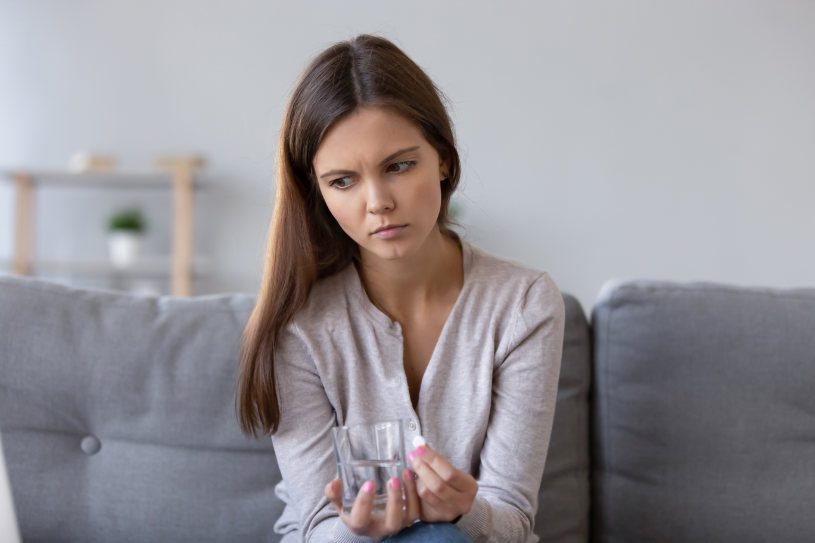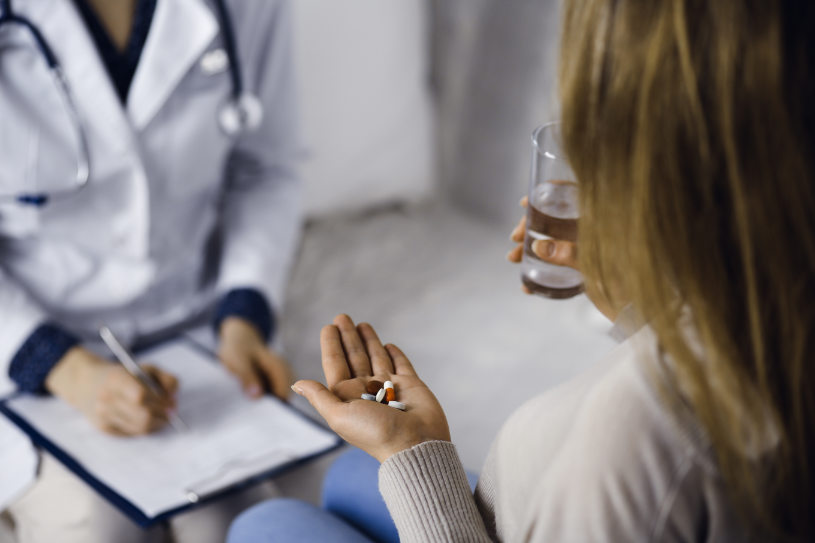Dextromethorphan is present in most OTC cough medicines. The Dextromethorphan class belongs to a cough category called antitussive drugs. In a recommended DXM dose, the side effects are rarely observed. However, when a patient self-medicates and does not follow the instructions about the proper intake of the drug, dangers to the health, including coma or death, may occur. In 2006, there was an increase in the misuse and abuse of this medication by teens in the United States. For this reason, it is essential to follow Dextromethorphan dosage instructions, such as the right time when to take the drug, printed on the product label when using a cough medicine with Dextromethorphan.
Table Of Contents:
The use of cough medicine with this medication requires following the dosage guide, either given by a doctor, to avoid overdose effects. In this article, information about accurate dosing, Dextromethorphan products formulation, different DXM dosage forms, the recommended DXM dose, and what DXM doses are safe to use will be provided.

Formulations of Medicines with Dextromethorphan
Every drug comes with different formulations and these formulations are made in order for a patient to receive the medication safely and effectively. Aside from Dextromethorphan hydrobromide, this medication also comes with different formulations such as DXM HBr, Dextromethorphan DPH (Diphenhydramine), polistirex, gel caps, and pills:
- DXM HBr – This is the Hydrobromide form of Dextromethorphan. It can also be referred to as DXM cough syrup and this formulation is widely available in the pharmaceutical market.
- DXM DPH – This formulation is a Dextromethorphan-diphenhydramine combination and it is used to treat not just cough but also colds, stuffy nose, and sneezing caused by allergies. This formulation may also contain Phenylephrine.
- DXM polistirex – DXM Polistirex dosage formulations are extended-release products. Each 5ml of this product is equivalent to 30mg of Dextromethorphan HBr.
- DXM gel caps – These formulations are also known as liquid gels or cough gels. Inside the soft gelatin capsules is the Dextromethorphan HBr formulation.
- DXM pills – These formulations are also known as relief tablets but in smaller sizes. These pills are also available over-the-counter but they can only be bought by adults. Also, these pills are not widely available in all pharmaceutical markets.
Since this drug comes with different formulations, self-medication is not recommended as they come with different dosage strengths. It is always advisable to consult a medical professional to understand what is the best DXM dose and formulation to choose.
Since the formulations are different from each other, the DXM dosage or frequency of use will differ as well while considering the characteristics and other health conditions of a patient. Having said this, only a doctor can give information about the right amount of the drug to be consumed and the right time to take it.
Medical DXM Dosage
This drug is available in the form of syrup, lozenges, tablets, and gel capsules. Each product form contains different quantities, and every brand of cough medicine has its dosage and time recommendations. The recommended amount depends on the strength of the medicine, the number of DXM doses each day, the number of dosing intervals, patient age and weight, and other pathological conditions the patient may have.
Below Is Information About the Different Forms of the Drug With Respect to DXM Dosages and Strengths:
- Dextromethorphan HBr (hydrobromide)
- Combination of antihistamine and cough suppressant
- Also known as Dextromethorphan cough syrup
- Usually comes in an amber container containing 60mL or 120mL total solution
- The usual dosage strengths are 5mg/5mL, 7.5mg/5mL, 10mg/5mL,15mg/5mL, and 20mg/5mL
- DXM polistirex dosage
- Extended-release version and comes in different forms:
- Liquid – comes in an amber container and the usual dosage strength for pediatrics (6-12 years old) is 3mg/mL
- Oral suspension – also comes in an amber container and the usual dosage strengths are 10mg/5mL and 15mg/5mL
- Tablet – comes in an oblong shape with round edges, yellow in color, and the usual dosage strength is 1200mg/60 mg
- Extended-release version and comes in different forms:
- Gel caps
- Comes in a soft gel capsule with a dosage strength of 7.5mg/5mL
- The color of the solution inside the capsule may be light yellow, red, or orange
- Pills dosage
- Small (pill-like), light green in color with no imprints but scored and the usual dosage strength is 15mg
- Those pills which are not scored are film-coated
- Lozenge
- Usually comes in red and orange color
- Circle-shaped and the imprints depend on the brand
- The usual dosage strengths are 5mg, 7.4mg, and 15mg
Since the formulations are different from each other, the DXM dosage or frequency of use will differ as well while considering the characteristics and other health conditions of a patient. Having said this, only a doctor can give information about the right amount of the drug to be consumed and the right time to take it.

Factors Affecting Accurate DXM Dosing
There are many factors that affect the accuracy of the DXM dosing. Aside from the external factors like the measuring cup used for the syrup form, spillage, or the way how a tablet was halved or crushed, factors like sex also play a role.
In Compliance with the Factors Modifying Drug Dose-Response Relationship There Can Be Singled out Such Features as:
- Age and metabolism – in younger patients, metabolism is slower and their renal clearance is diminished. Also, in adults, metabolism is altered and these are reasons why a doctor is the only one who can tell about the right dose to be given to a patient.
- Sex – response is different when it comes to men and women even if the drug is the same. Some are more effective in women and some are more effective in men. Although the responses are different, metabolism still plays an important role.
- Bodyweight and composition – Dextromethorphan gives higher concentration to people with smaller body weight and size. For this reason, a doctor will calculate the proper amount of this drug to consume based on the body surface area of a patient.
- Polypharmacy – is more importantly noted on older patients and patients with other medical conditions. A doctor will prescribe the right amount of Dextromethorphan considering the other drugs being taken by the patient. If a patient self-medicates while on other drugs, possible dangers to the health such as an overdose and severe drug reactions caused by interactions might occur.
Knowing the proper amount of DXM doses to consume is important when taking this medication, as an overdose may occur when an incorrect dose is taken. Additionally, continually using Dextromethorphan-containing drugs without considering the proper dose and time may lead to tolerance. Do not self-medicate on this drug even if it is an OTC. Always consult a doctor to get the proper dose.
Dextromethorphan Maximum Recommended Dosage
The max adult DXM Dosage is established based on the amount of this medication in the product selected. The max dose in adults is 120 mg/24 hours. However, DXM dosing depends on many individual factors, along with the patient’s needs.
Other Factors That a Medical Doctor Considers When Recommending a Dxm Dosages Are the Following:
- What is the condition a doctor would like to treat using this drug?
- What are other drugs being taken by a patient?
- Is the patient a neonate, child (6-12 years old), or elderly?
- What are the other health conditions of the patient?
In the event of accidental use or misuse of the medication such as when a patient is taking the medicine more than the recommended dose, intoxication and dangerous adverse reactions begin to appear. Additionally, tolerance might also be experienced. When not exceeding the maximum recommended DXM dosage, it is safely tolerated without side effects. However, the dosage will always depend on the prescription of a doctor.
DXM Doses For Safe Use
Dextromethorphan is an OTC medication that is used as a cough suppressant. Although it can be bought over-the-counter, it is important to know the proper DXM dosage strength and form to be used and this can only be given by a doctor. There are many factors that affect the dosing of this drug such as the age and the weight of a patient. Additionally, Dextromethorphan comes in different dosage formulations like the DXM polistirex dosage and with this, the max dose limit should always be noted because a patient who overdosed on this drug or a patient who misused the drug may experience tolerance which is dangerous to their health.
Moreover, using Dextromethorphan for coughing in the recommended therapeutic dose is safe, but prolonged use or taking high DXM doses increases the incidence of abuse. High DXM doses can cause tolerance, addiction, and intoxication. The chances of successfully treating addiction will be higher with the help of addiction treatment programs like a dextromethorphan detox program. If assistance is needed to complete the process, start the detox off Dextromethorphan. Also, seek help at the drug rehab center, where there follow-up and specialized care by specialists.
Hope Without Commitment
Find the best treatment options. Call our free and confidential helpline
Most private insurances accepted
Page Sources
- Dextromethorphan Polistirex Extended-release Suspension 12 Hour Cough Relief Orange. (2017). Retrieved from https://dailymed.nlm.nih.gov/dailymed/fda/fdaDrugXsl.cfm?setid=ce7402d1-e48f-4bf1-90e9-cc57a52b35e5&type=display
- Journey, J. D., Agrawal, S., & Stern, E. (2019). Dextromethorphan Toxicity. StatPearls [Internet].
- Wilson, M. D., Ferguson, R. W., Mazer, M. E., & Litovitz, T. L. (2011). Monitoring trends in dextromethorphan abuse using the National Poison Data System: 2000–2010. Clinical toxicology, 49(5), 409-415.

 Authored by
Authored by  Reviewed by
Reviewed by 
